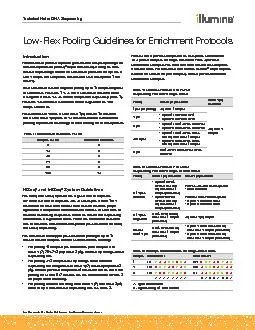/


Index 1 i7 Table 2 Libraries Pooled 7 or more Sequencing Workow Single or Dual Index Index 1 i7 Index 2 i5 715012 plex option 1 N701 N702 N704 and any other Index 1 option 2 N703 ID: 142535
Download Pdf The PPT/PDF document "Technical Note: DNA Analysis" is the property of its rightful owner. Permission is granted to download and print the materials on this web site for personal, non-commercial use only, and to display it on your personal computer provided you do not modify the materials and that you retain all copyright notices contained in the materials. By downloading content from our website, you accept the terms of this agreement.
Technical Note: DNA Sequencing For Research Use Only. Not for use in diagnostic procedures.IntroductionThis document provides important guidelines for low-plex pooling with enrichment protocols (TruSeqindexed sequencing work ow for enrichment protocols, always use at least 2 unique and compatible barcodes for each index (Index 1 and Each enrichment reaction supports pooling up to 12 samples together for enrichment. There are 1, 2, 4, and 8 enrichment reactions worth of reagents in the 8, 24, 48, and 96 sample kits, respectively (Table 1). There are 24 enrichment reactions worth of reagents in the 288 There is suf cient volume in each Index 1 (i7) tube for 16 reactions and in each Index 2 (i5) tube for 24 reactions. Illumina recommends planning experiments accordingly to avoid running out of index primers. Table 1: The HiSeq and MiSeq Systems use a green laser to sequence G/T and a red laser to sequence A/C. At each cycle at least 1 of 2 nucleotides for each color channel must be read to ensure proper registration. It is important to maintain color balance for each base of could fail due to registration failure. Follow the instructions described here to determine which libraries are pooled pre-enrichment for HiSeq The enrichment kits support pre-enrichment pooling of up to 12 different indexed samples. Illumina recommends the following:For pooling 12 samples pre-enrichment, pool samples with sequencing run using different Index 1 (i7) indexes (any Index 2 (i5)). Illumina provides compatible i5 indexes in this kit, but when pooling fewer than 6 i7 indexes, use the combinations in Table 2 for proper color balancing. Table 2: Sequencing Work ow: Single Index Table 3: Libraries Pooled: 7 or More; Sequencing Work ow: Single or Dual IndexWith 24-, 48-, and 96-sample kits: Technical Note: DNA Sequencing • 1.800.809.4566 toll-free (US) • +1.858.202.4566 tel • techsupport@illumina.com • www.illumina.comFor Research Use Only. Not for use in diagnostic procedures.© 2014–2015 Illumina, Inc. All rights reserved. Illumina, HiSeq, MiSeq, Nextera, NextSeq, TruSeq, and the pumpkin orange color are trademarks of Illumina, Inc. and/or its af liate(s) in the U.S. and/or other countries. Pub. No. 770-2013-060 Current as of 23 September 2015 NextSeq Systems use 2-channel sequencing, which requires only 2 images to encode the data for 4 DNA bases: 1 red channel and 1 green channel. The NextSeq also uses a new implementation of Real-Time Analysis (RTA) called RTA2.0, which includes important architecture differences from RTA on other Illumina sequencing systems. For any index sequences, RTA2.0 requires that there is at least one base other than G in the rst 2 cycles. This requirement for index diversity allows the use of any Illumina index selection for single-plex indexing except index 1 (i7) 705, which uses the sequence GGACTCCT. Use the combinations in Table 6 for proper color balancing on NextSeq Systems. Table 5: Table 6: 3–6 plex—Use the indexes required for a 3-plex pool and select from the indexes required for a 6-plex pool.6–9 plex—Use the indexes required for a 6-plex pool and select from the indexes required for a 9-plex pool.9–12 plex—Use the indexes required for a 9-plex pool and select from the indexes required for a 12-plex pool.